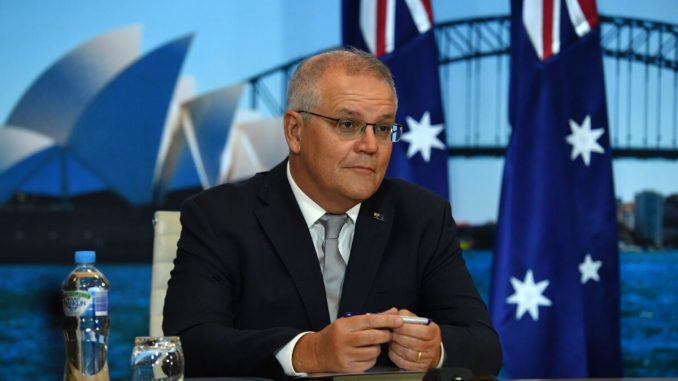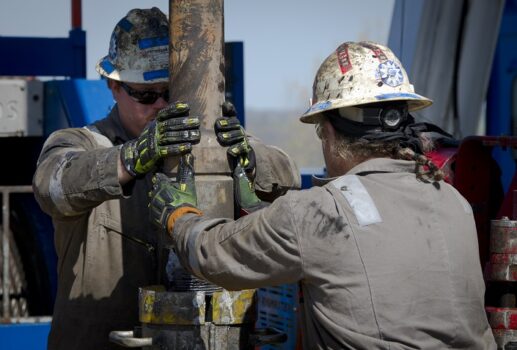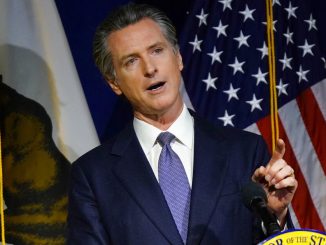
Australian Prime Minister Scott Morrison is betting on hydrogen technology as the way forward to cutting greenhouse gas emissions, rather than setting new climate targets like fellow industrialised nations.
On Thursday, the Leaders’ Summit on Climate was held online and chaired by U.S. President Joe Biden.
Prime Minister Morrison told the summit that Australia was on a “pathway to net zero.”
“Our goal is to get there as soon as we possibly can, through technology that enables and transforms our industries, not taxes that eliminate them and the jobs and livelihoods they support and create, especially in our regions,” he said.
“Mr President, in the United States you have the Silicon Valley. Here in Australia, we are creating our own ‘Hydrogen Valleys,’” he added. “Where we will transform our transport industries, our mining and resource sectors, our manufacturing, our fuel and energy production.”

Morrison also emphasised Australia’s track record at reducing emissions saying the country was due to meet its 2020 Kyoto Protocol and its 2030 Paris Agreement commitments.
“Already we have reduced our emissions by 19 percent on 2005 levels, more than most other similar economies—and by 36 percent when you exclude exports,” he said.
“It’s right to speak to our ambitions at this summit. It’s also right to focus on performance.”
The United States, United Kingdom, and the European Union previously pledged to reach net-zero by 2050. A target Prime Minister Morrison has said Australia would aim for but would not commit to.
During the Leaders’ Summit, U.S. President Biden pledged to reduce U.S. emissions by 50 to 52 percent by 2030.
Across the pond in Europe, the UK pledged a 78 percent reduction in its emissions by 2035, in what UK Prime Minister Boris Johnson called “the most ambitious target” in the world.
That target will see the UK embark on a fundamental restructuring of how the nation powers its homes, cars, factories, and food production.
The target beat out the EU who pledged to reduce emissions by 55 percent by 2030. Other countries to announce new targets included Japan (46 percent by 2030), Canada (45 percent by 2030), and Brazil (net zero by 2050), fast-tracking its previous goal by ten years.

Australia’s current 2030 emissions reduction target will remain at 26 to 28 percent, which has spurred climate change groups to push for more radical action.
“Regardless of any net-zero date the federal government sets, what we need to see is a clear plan for getting there that includes making deep and rapid emissions cuts this decade,” Fiona Davis, acting chief of Farmers for Climate Action, said.
Meanwhile, The Climate Council of Australia called for a target of 75 percent by 2030 and net-zero by 2035.
Associate Professor Salvatore Babones, an expert in the Asian political economy at the University of Sydney, said the Biden administration would expect Australia to increase its commitment.
“Australia is likely to face pressure from Joe Biden to make at least a nominal carbon promise of some kind, just to show that he has been successful in bringing allies on board with his program,” he told The Epoch Times.
Babones noted in January (pdf) that the new administration would “press home” a major climate agenda, especially as the Democrats now control both houses of Congress, emissions rates have continued dropping since the early 2000s, and average U.S. households enjoy affordable energy prices due to the shale gas boom.

Australians, in contrast, pay some of the highest energy prices in the world and coal-mining dependent regions have pushed back strongly on the climate agenda.
“Only in 2019, Australia had what was pitched by activists as the ‘climate election’ where mainstream Australians rejected economically destructive climate policy,” Daniel Wild, director of the Institute of Public Affairs, told The Epoch Times.
The Australian Labor Party, traditionally the party of the working class, lost a significant portion of voters outside of the inner-city regions in response to its energy policy.
It prompted former Shadow Minister for Agriculture Joel Fitzgibbon to urge the party to rejig its focus and “reconnect” with its base, which it has moved to address in the past week.
Babones also said Australia would remain relatively insulated from the push for renewables, saying developing countries would continue to have a high demand for coal.
“Right now, the biggest threat to coal exports comes from anti-mining agitation within Australia itself,” he said.
“Any serious reduction in global coal use is still at least a decade away, whatever people say at climate summits,” he added. “That’s because most coal is burned in poor and middle-income countries like China that are not participating in climate targets.”





Be the first to comment